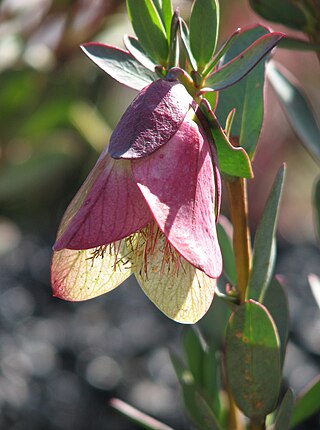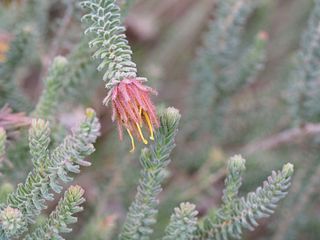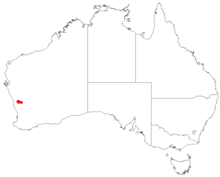
Darwinia, sometimes commonly known as mountain bells or simply bells, is a genus of about 70 species of evergreen shrubs in the family Myrtaceae, endemic to southeastern and southwestern Australia. The majority are native to southern Western Australia, but a few species occur in South Australia, New South Wales and Victoria. The genus was named in honour of Erasmus Darwin, grandfather of Charles Darwin by Edward Rudge in 1816. Most darwinias grow to a height of between 0.2 and 3 m, and many are prostrate shrubs. Most have small, simple leaves and the flowers are often grouped together, each flower with five red, white or greenish petals and ten stamens. In many species, the flowers are surrounded by large, colourful bracts, giving rise to their common names.

Pimelea physodes, commonly known as Qualup bell, is a species of shrub that is endemic to Western Australia. It has egg-shaped to narrow elliptical leaves and distinctive bell-like inflorescences with tiny greenish flowers surrounded by long elliptical bracts. The inflorescence resembles those of some of the only distantly-related darwinia "bells" and the bracts are a combination of red, purple, green and cream-coloured.

Darwinia meeboldii, commonly known as Cranbrook bell, is a species of flowering plant in the family Myrtaceae and is endemic to the south-west of Western Australia. It is an erect, spindly shrub with crowded leaves and clusters of pendent flowers surrounded by large bracts.

Pimelea serpyllifolia, commonly known as thyme riceflower, is a species of flowering plant in the family Thymelaeaceae and is endemic to southern Australia. It is an erect shrub with narrowly elliptic to spatula-shaped leaves, and compact heads of 4 to 12 yellow, yellowish-green or white flowers surrounded by 2 or 4 leaf-like involucral bracts. Male and female flowers are borne on separate plants.

Darwinia oxylepis, commonly known as Gillham's bell, is a plant in the myrtle family Myrtaceae. It grows as a dense, upright shrub 1.0–1.5 m (3.3–4.9 ft) high, and produces large numbers of red inflorescences prominently displayed on the ends of the branchlets in spring. It is one of a group of Darwinias including D. leiostyla, D. macrostegia, D. meeboldii, D. collina and D. squarrosa collectively known as mountain bells. The species is found in only a few seasonally moist gullies near the lower slopes of the Stirling Range National Park and nearby Porongurup National Park and is therefore classified as endangered.

Darwinia virescens, commonly known as Murchison darwinia, is a species of flowering plant in the family Myrtaceae and is endemic to a small area on the west coast of Western Australia near Geraldton. It is a prostrate or low-lying shrub with crowded linear leaves and dense, hemispherical heads of green, yellow or red flowers.

Darwinia apiculata, commonly known as the scarp darwinia, is a plant in the myrtle family Myrtaceae and is endemic to a small area in Western Australia. It is a rounded, densely branched, small shrub with thin red branches and scattered small leaves. The flowers are arranged in small groups on the ends of the branches, their most obvious feature being long, red, pointed bracts surrounding each flower and a longer red style with scattered hairs near its tip.

Darwinia chapmaniana, commonly known as Chapman's bell or Eganu bell, is a plant in the myrtle family Myrtaceae, and is endemic to the south-west of Western Australia. It is a low, rounded, spreading shrub with greyish, hairy leaves and flowers in heads of about 14 small, tubular flowers. The heads are surrounded by long, reddish-yellow, hairy bracts.

Darwinia wittwerorum, commonly known as Wittwer's mountain bell, is a plant in the myrtle family Myrtaceae and is endemic to a small area in Western Australia. An erect, spindly shrub with fine leaves and hanging groups of flowers surrounded by leaf-like bracts, it is one of the darwinias known as mountain bells.

Darwinia ferricola, commonly known as the Scott River darwinia, is a plant in the myrtle family Myrtaceae and is endemic to a small area in Western Australia. It is a rounded, densely branched shrub with crowded, linear leaves mostly only on younger branches. The flowers are greenish-yellow and red, and arranged in groups on the ends of the branches, with a long white or reddish style protruding from the petal tube.

Darwinia foetida, commonly known as Muchea bell, is a plant in the myrtle family Myrtaceae, and is endemic to Western Australia. It is a small upright shrub with greenish coloured nodding flowers at the apex of the stems, that have an unpleasant odour. This is a very restricted species, known from only a couple of locations.

Darwinia helichrysoides is a species of flowering plant in the myrtle family Myrtaceae and is endemic to a small area in south-west of Western Australia. It is a slender shrub with linear leaves and drooping heads of about 4 red and green flowers surrounded by many glabrous bracts.
Darwinia nubigena, commonly known as success bell or red mountain bell, is a species of flowering plant in the family Myrtaceae and is endemic to the south of Western Australia. It is an erect shrub with egg-shaped leaves arranged in opposite pairs, and groups of 4 or 5 pendent red flowers surrounded by larger green and red bracts.

Darwinia pimelioides is a species of flowering plant in the family Myrtaceae and is endemic to the southwest of Western Australia. It is an erect shrub with broadly oblong leaves and heads of drooping flowers surrounded by larger red to pink and green bracts.
Darwinia terricola, commonly known as the Blackwood bell, is a species of flowering plant in the myrtle family Myrtaceae and is endemic to a small area in the south-west of Western Australia. It is a small, low, sometimes prostrate shrub with small, linear leaves and small groups of flowers surrounded by reddish-green bracts and which usually lie on the ground.

Darwinia whicherensis, commonly known as the Abba bell, is a plant in the myrtle family Myrtaceae and is endemic to the south-west of Western Australia. It is a small shrub with linear leaves and bell-shaped, flower-like inflorescences containing more than twenty flowers surrounded by bracts, the largest of which are red with green edges.

Pimelea cracens is a species of flowering plant in the family Thymelaeaceae and is endemic to the southwest of Western Australia. It is an erect, spindly shrub with narrowly elliptic to egg-shaped leaves and creamy green to pale yellow flowers surrounded by 6 or 8 yellowish or pale green and reddish involucral bracts.
Pimelea graniticola is a species of flowering plant in the family Thymelaeaceae and is endemic to the southwest of Western Australia. It is a shrub with linear leaves and large clusters of erect, cream-coloured or white flowers surrounded by about 40 green involucral bracts.
Pimelea neokyrea is a species of flowering plant in the family Thymelaeaceae and is endemic to the southwest of Western Australia. It is a low, spreading shrub with narrowly egg-shaped to narrowly ellipic leaves and erect clusters of white or pale yellow flowers surrounded by egg-shaped involucral bracts. It was previously included in Pimelea avonensis.
Guichenotia alba is a flowering plant in the family Malvaceae and is endemic to Western Australia. It is a slender, spreading shrub with lax, hairy young branches, leaves with the edges rolled under, and white flowers.

















